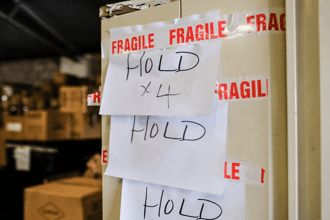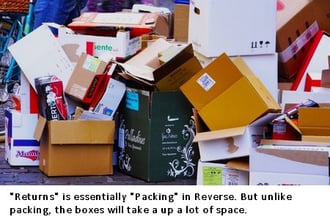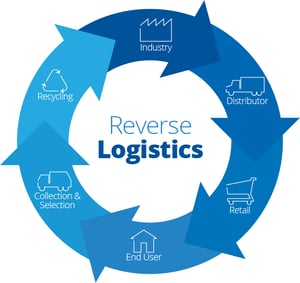
If you sell goods online, you know that stuff comes back at a predictable rate. People make mistakes when ordering, find that something doesn’t suit their needs, or get a product in the mail with some type of defect. You might have perfected your logistics process, but what happens when items need to move in the opposite direction?
Some businesses don’t give a lot of thought to reverse logistics until the process becomes overwhelming or broken. Here is what you need to know about reverse logistics and why your business should be focusing on it right now.
What is Reverse Logistics?
Reverse logistics is a form of supply chain management that moves products from the customer back to the manufacturer or seller. Once the customer receives the product and decides to return it, the reverse logistics process begins. Reverse logistics involves several steps, which include return shipping, return processing, movement to disposition, and resale or recycling.
5 Reasons to Make Reverse Logistics a Priority
Now that you know what reverse logistics entails, why would a business go to the trouble of setting up a reverse logistics process? What do you have to gain from making this part of your operation a priority? Here are five reasons why your business should think about focusing on reverse logistics as part of its overall strategy.
1. Customer Satisfaction
 As a business, one of your primary goals should be to increase customer satisfaction and boost retention rates. You can accomplish this with a robust reverse logistics process.
As a business, one of your primary goals should be to increase customer satisfaction and boost retention rates. You can accomplish this with a robust reverse logistics process.
When you sell goods online, you can expect a high rate of returns, even if your products are amazing. Everyone’s tastes are different. But consumers have found that they love online shopping for its convenience and want an equally convenient returns process.
A recent survey found that there is a stark difference in return rates between in-store and online shopping. An in-store purchase has an average return rate of 8-10%, while online purchases have average return rates of 20%. The return rate for “expensive products” is a shocking 50%.
Global shipping company UPS reports that 95% of customers will refuse to shop with a business again if they have a bad returns experience. Having a hassle-free returns process is one way to boost customer satisfaction and increase retention rates.
2. Value of Goods
 When you repurpose returned goods, it helps manufacturers boost the value of goods that might otherwise need to be discarded or sold at an extreme discount. Just think about the alternative. Without reverse logistics, your business would have to throw away returned products or even pay to have them discarded.
When you repurpose returned goods, it helps manufacturers boost the value of goods that might otherwise need to be discarded or sold at an extreme discount. Just think about the alternative. Without reverse logistics, your business would have to throw away returned products or even pay to have them discarded.
Some returned items come back unopened and can be sent directly back to inventory after a quick inspection. Others might need to be repackaged or repaired and then slightly discounted before they can be resold. When you are able to sell those goods a second time, this increases the value of those goods to your business above what you’d have to write off as a lost sale.
3. Sustainability
Now more than ever, consumers care about sustainability issues. When your business repurposes returned goods and show that it cares about sustainability, it can enhance your brand’s reputation.
A Deloitte survey found that nearly one-third of consumers stopped shopping with a brand because of sustainability or ethics concerns over the past year. 34% of those surveyed chose to shop with brands that had environmentally sustainable values or practices.
According to a 2019 research study, there is a direct positive impact on environmental sustainability from reverse logistics through waste reduction. In short, sustainability is good for business, and this is something you can pursue and promote through your reverse logistics program.
4. Business Insights
If you don’t have data about what’s being returned and why, your business is essentially operating in the dark. And that can be a recipe for disaster. A robust reverse logistics program will give your business valuable insights that you can use to improve various aspects of your operations.

When you give reverse logistics the time, attention, and resources it needs, you’ll find out key information about your business and its customers. Examples include:
- Your overall rate of returns
- The rate of return for certain goods
- The reasons goods are being returned
- Common issues with certain products
- The value of goods you can recapture
This data can be used to improve the customer experience as well as create a more efficient reverse logistics process.
5. Cost Savings

We already said - more people shopping online means higher return rates. But that doesn’t necessarily have to mean those returns are going to harm your business. A streamlined and well-planned reverse logistics process can not only reduce losses but improve your brand’s reputation.
In one recent survey of 1,000 shoppers, 89% claims they’ve purchased an item online and returned it. Another 41% admitted they had purchased multiple versions of an item with the intention of returning some of them.
Without an efficient process for communicating with customers about returns, handling shipping, processing incoming goods, and repurposing products, your business could lose a lot of money. Organized correctly, you can bring returned goods back into the warehouse, inspect them, repair them if necessary, and put them back into inventory to reduce costs and make your business more money.
Refining Your Reverse Logistics Process
 With the advent of Free Shipping, consumers aren’t shy about returning products that don’t meet their needs. How businesses handle these returns can make a difference in customer satisfaction levels and overall business results.
With the advent of Free Shipping, consumers aren’t shy about returning products that don’t meet their needs. How businesses handle these returns can make a difference in customer satisfaction levels and overall business results.
Instead of treating reverse logistics as an afterthought, it makes sense to create a thorough strategy combining a fast customer response with ways to recapture product value. For many businesses, leveraging existing warehouse technology solutions is the answer.
For example, a warehouse management system (WMS) can process returns, send automatic shipping labels, and track returned products as they move through the system. By creating a separating staging area for incoming returns, your business can process them using portable warehouse technology tools to recapture value as quickly as possible.
Putting Reverse Logistics to Work for Your Business
When implemented properly, reverse logistics can benefit your business in several ways. It helps reduce transportation, administrative, and support costs while increasing efficiency. It also improves customer satisfaction because people want and expect a seamless return policy from the brands they trust. If your business doesn’t have a winning reverse logistics strategy, now is the time to make this part of the business one of your priorities.
